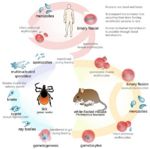Difference between revisions of "Babesia"
Fiorecastro (talk | contribs) |
Fiorecastro (talk | contribs) |
||
| (2 intermediate revisions by 2 users not shown) | |||
| Line 1: | Line 1: | ||
| − | + | [[Image:Babesia Life Cycle.jpg|thumb|right|150px|''Babesia'' Life Cycle Diagram - Dennis Jacobs & Mark Fox RVC]] | |
| + | [[Image:Alternative Babesia life cycle diagram.jpg|thumb|right|150px|''Babesia'' Life Cycle - Mariana Ruiz Villarreal]]Until recently this was not a problem in the UK. Since the introduction of the Pet Passport scheme cases of this tick transmitted disease are being seen more frequently. Infection is associated with both intravascular haemolysis and extravascular haemolysis (due to infected cells being sequestered and lysed in the spleen). Diagnosis is by PCR or by demonstrating the intracellular teardrop shaped organisms, particularly in smears of capillary blood (ear margin). References: [[NationWide Laboratories]] | ||
*Infects a wide range of host species in different areas of the world | *Infects a wide range of host species in different areas of the world | ||
Babesiosis has severe effects on cattle production in parts of the world. First of all, it prevents European breeds from being successful in tropical regions where [[Ticks|ticks]] are endemic as well as occurring sporadically in the UK and Ireland causing losses of around £8 million per year. | Babesiosis has severe effects on cattle production in parts of the world. First of all, it prevents European breeds from being successful in tropical regions where [[Ticks|ticks]] are endemic as well as occurring sporadically in the UK and Ireland causing losses of around £8 million per year. | ||
| − | + | '''Life Cycle''' | |
Both [[Ticks#Disease Transmission|trans-stadial]] and [[Ticks#Disease Transmission|trans-ovarian]] transmission occurs with each female [[Ticks|tick]] producing 3000 eggs and the [[Ticks|tick]] being the definitive host. | Both [[Ticks#Disease Transmission|trans-stadial]] and [[Ticks#Disease Transmission|trans-ovarian]] transmission occurs with each female [[Ticks|tick]] producing 3000 eggs and the [[Ticks|tick]] being the definitive host. | ||
| Line 54: | Line 55: | ||
*'''Lower''' incidence of disease | *'''Lower''' incidence of disease | ||
| − | |||
<big>'''[[Babesiosis - Cattle|Cattle Babesiosis]] | <big>'''[[Babesiosis - Cattle|Cattle Babesiosis]] | ||
| − | '''[[Babesia canis]] | + | '''[[Babesia canis]] |
| − | '''[[Babesiosis - Horse|Horse Babesiosis]] | + | '''[[Babesiosis - Horse|Horse Babesiosis]] |
'''[[Babesiosis - Small Ruminants|Sheep and Goat Babesiosis]] | '''[[Babesiosis - Small Ruminants|Sheep and Goat Babesiosis]] | ||
Revision as of 21:00, 7 March 2022
Until recently this was not a problem in the UK. Since the introduction of the Pet Passport scheme cases of this tick transmitted disease are being seen more frequently. Infection is associated with both intravascular haemolysis and extravascular haemolysis (due to infected cells being sequestered and lysed in the spleen). Diagnosis is by PCR or by demonstrating the intracellular teardrop shaped organisms, particularly in smears of capillary blood (ear margin). References: NationWide Laboratories
- Infects a wide range of host species in different areas of the world
Babesiosis has severe effects on cattle production in parts of the world. First of all, it prevents European breeds from being successful in tropical regions where ticks are endemic as well as occurring sporadically in the UK and Ireland causing losses of around £8 million per year.
Life Cycle Both trans-stadial and trans-ovarian transmission occurs with each female tick producing 3000 eggs and the tick being the definitive host.
Babesia multiplies in the red blood cells by budding and it forms 2-4 daughter cells (species dependent). Giemsa blood smears can differentiate between species using 'Difquik' stain.
- Babesia species are either small or large depending on the size of the daughter cells
- Small Babesia
- E.g. B. divergens
- E.g. B. gibsoni
- Peripheral nucleus
- Obtuse angle
- Large Babesia
- E.g. B. major
- E.g. B. canis-complex
- Central nucleus
- Acute angle
- Daughter cells disrupt the red blood cell and are released
- Spread and infect other red blood cells
- Antigen is released which adsorbs onto other red blood cells
- Causes haemolysis and haemoglobin pigmentation
- Causes haemolytic anaemia, haemoglobinuria and fever
Enzootic Instability
- Low rate of transmission
- Few infected ticks
- Infrequent exposure
- Immunity wanes or is completely absent in many individuals
- Low levels of herd immunity
- Higher incidence of disease
Enzootic Stability
- High rate of transmission
- Many infected ticks
- Frequent exposure boosts immunity
- High level of herd immunity
- Lower incidence of disease
- Babesia bovis myositis
- In cattle
- Infrequent muscle necrosis

